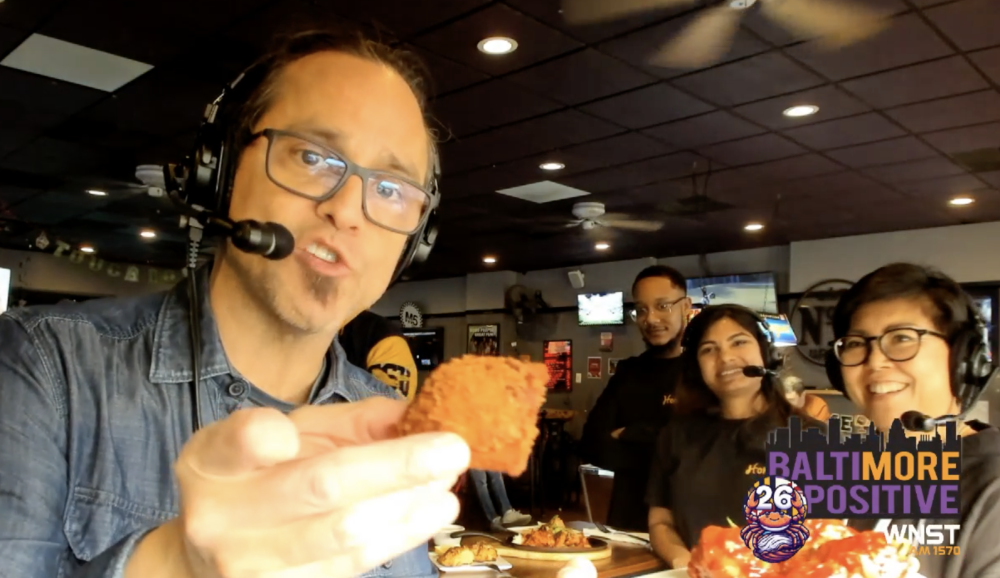“It’s a son talking to a father, that’s the way I looked at it. It’s hard talking about someone who loved you that much. It’s not as easy as you think it is. Everything I said in his ear came from my heart and I loved him dearly,”
— Ray Lewis (September 2012)
THE PAINTING HANGS OVER THE majestic fireplace at The Castle in Owings Mills and exudes the warmth of the man himself. Arthur Bertrand Modell. Founder. Baltimore Ravens.
Like several others in this purple tale of civic sports personalities who are more worthy of a book than a chapter, one could write tomes outlining the full color and complexity of the life and times of Arthur B. Modell. After nearly a lifetime of working the football business on the banks of Lake Erie beginning in March 1961 in his adopted homeland of Cleveland, the native New Yorker brought his beloved Browns franchise to Baltimore in November 1995 amidst national scorn. He was forever reviled in Ohio and beloved in Maryland. The economic reasons for the move are well documented. And Modell was clear that there were no other motives except for self-preservation, abandoning a decrepit stadium un-affectionately known as “The Mistake On The Lake” that was built in 1930. Coming to the shores of the Chesapeake Bay in an attempt to finally win a Super Bowl and create equity and a trust fund for his family in the only business he owned or cared about during his life was his only motivation.
Or as he once famously said regarding Baltimore, “I didn’t come here for the crab cakes!”
Five years later, on a team with four Hall of Famers, the Ravens won Super Bowl XXXV and forever changed the Baltimore sports landscape. The Ravens went from being a carpet-bagged sports franchise to a civic institution.
The unique part of the Ravens, being such a young franchise, is the amazing institutional memory that exists within a relatively new building and a teenage organization that has become the model for the NFL. Modell understood football’s value to a local community. He understood the allure of sports, and he recognized the partnership that a franchise needed to have with all elements of the fan base – men and women, children, and adults, rich and poor, black and white, blue collar and white collar, Jew, Gentile and non-believers. Art believed that a sports team could galvanize all parts of a community in a way that no other entity could muster.
And who would know more than Modell? He truly was one of a handful of pioneers who helped build the National Football League from a third-rate sport on the fringe of society in the early 1960s into the centerpiece of the American sports landscape during his 42 years of ownership.
Modell will be remembered for owning a football team in Cleveland and moving it to Baltimore, but he lived a very full life before he even arrived in Ohio as a well-heeled New York ad man who gave up his East Coast life and moved to the friendly heart of the Midwest. There, he sold football and lived football like his contemporaries Pete Rozelle, Al Davis, Lamar Hunt, and the other forefathers of modern football by immersing in the community and the sport and selling his ass off.
Arthur Bertrand Modell was born in Brooklyn, New York on June 23, 1925, the son of a Jewish wine salesman named George. His father, who had lost everything in the 1929 depression, died in 1939 while on a business trip in Austin, Texas and Art, who was just 14, was devastated. “I never got over it,” he once said in a WNST.net interview.
Modell dropped out of school the following year and sought work in the Brookyn shipyards as an apprentice where he worked 18-hour days cleaning hulls, supporting his mother Kitty and sisters Pansy and Selma. When he turned 18, he joined the U.S. Army Air Corps and wound up in Illinois before returning to New York to seek work near home. After World War II, he enrolled in television school using government aid to receive tuition money, and in 1947 founded his own production company. He wanted to work for himself. Television was brand new, a cutting edge industry, and Modell lived in the fast lane. His company had a unique idea to market housewives waiting in line in grocery stores with a concept called “Market Melodies.”
He used the 1950s and his salesmanship to create campaigns that made businesses money. Modell became one of the original “Mad Men” of the advertising world – men on Madison Avenue in New York who were creating tastes, trends, and most importantly, sales, all across America as the United States adopted this amazing new invention called television into homes, hearts, and wallets.

Modell always loved sports, but during his ascent at L.H. Hartman, Co. in the advertising industry, he became particularly fond of the New York Giants, who played football at Yankee Stadium.
In 1960, his love of the Giants found its way into an opportunity and his desire to be in the business of football. He knew marketing. He saw what a hit football was on TV and how it inspired him to become an impassioned New York Giants fan.
Modell moved to Cleveland and purchased the Browns for $3.925 million, using only $250,000 of his own money, or pretty much all that he had to his name and then some.
“I went into hock and borrowed my money,” he said. “I told people, ‘Nobody has as many toasters and irons and ironing boards in the garage as I do from opening up accounts and borrowing money. You get few chances like this. To take advantage of the opportunity, you must have money and friends with more.”
He moved to Cleveland as the toast of the town and immediately fired legendary head coach Paul Brown, replacing him with Blanton Collier in 1963. It was the first time he felt the ire of his own customers in Cleveland. Some of the biggest Browns fans in the region had disdain for him from the beginning because Brown was beloved from the three NFL titles he’d won in 1950, 1954 and 1955, but Modell’s 1964 NFL Championship win, a 27-0 drubbing of Johnny Unitas and the Baltimore Colts, solidified his ownership commitment and hold on much of the fan base. He was a hero in Ohio, at least for a little while. And fittingly that championship game was the first title game broadcast nationally on CBS.
In the 1960s as the NFL and AFL competed with virulent venom and nastiness that would make Peter Angelos look like Mother Theresa, Modell was at the forefront of how to grow his team and the league. He realized television was the rocket ship, just as he had 15 years earlier in New York with grocery stores.
Modell was a true entrepreneur – he understood his product, knew how to market it, and realized it was a local business that needed to vest and permeate the community to be successful. It was show business. And Art knew show business. And he knew the best shows were the winners, the ones with the happy ending and the parade.
He took risks to have a successful business. He gambled. By all accounts, Modell had fun in the 1960s as a bachelor, raconteur, and man about town. He traveled extensively, rubbed elbows in Hollywood and with the jet set, Las Vegas crowd. While in Los Angeles, he made a date with a famous soap opera star, Patricia Breslin, who played the role of Maggie Baldwin on “General Hospital.” Modell had never watched a soap opera in his life and had no idea who she was from any of her movie work in Hollywood.



























